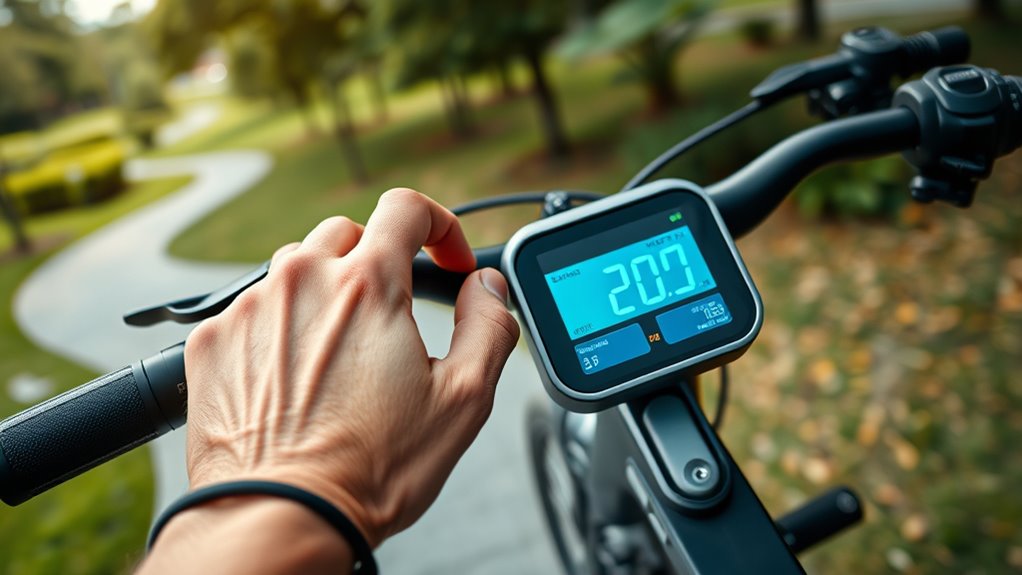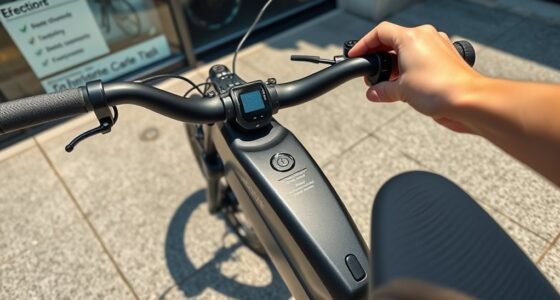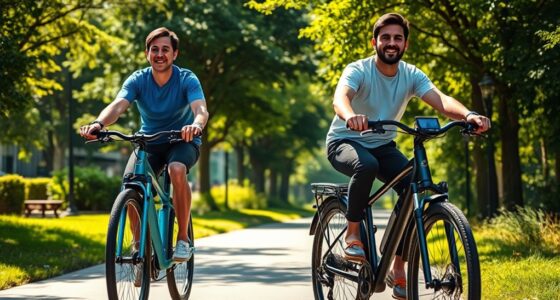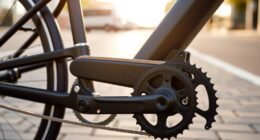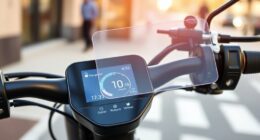Understanding e-bike wattage helps you choose the right motor power for your rides. A lower wattage, like 250W, suits city commuting and casual rides, while higher wattages like 500W or 750W are better for hills and off-road adventures. Your choice depends on terrain, distance, and local laws. Picking the right wattage balances performance and battery life. Keep exploring to learn how to match wattage perfectly to your needs.
Key Takeaways
- Match motor wattage to your terrain; higher wattage suits hills and rugged trails, lower wattage for flat, casual riding.
- Consider your typical riding distance; higher wattage and capacity extend range and performance.
- Check regional regulations; wattage limits (often 750W or less) ensure legal compliance and safety.
- Assess your riding style—more power for acceleration and steep inclines; conserve battery with lower wattage for simple commutes.
- Optimize system performance by balancing wattage with battery capacity and motor efficiency for best results.
What Does E-Bike Wattage Mean?
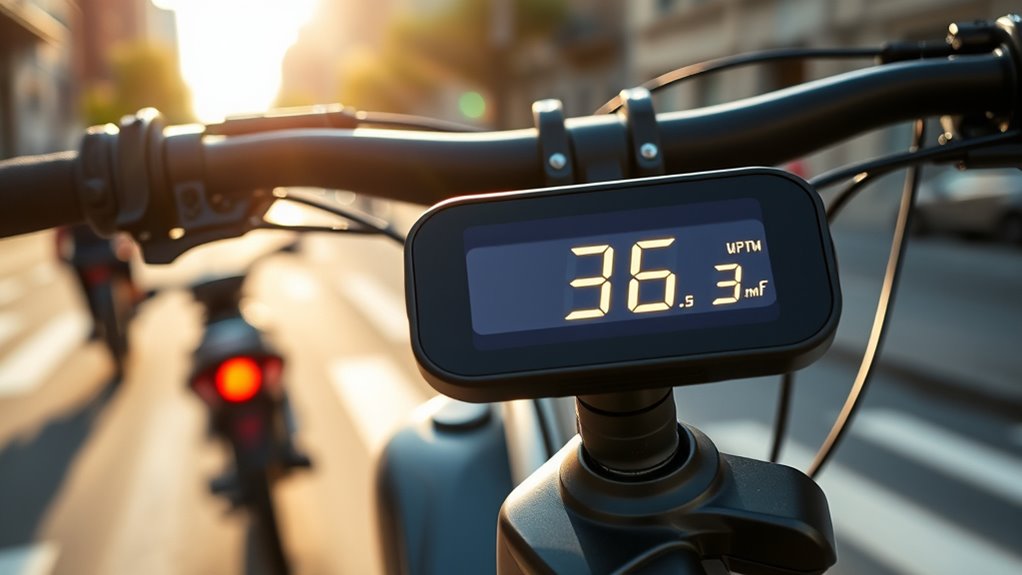
Have you ever wondered what e-bike wattage actually measures? It’s a key factor that indicates how powerful your motor is. Wattage reflects the amount of power your e-bike’s motor can produce, which influences acceleration and climbing ability. But it’s not just about the wattage number; battery capacity plays a role too, as it determines how long you can ride at that power level. Additionally, motor efficiency affects how effectively that wattage is converted into motion. A highly efficient motor makes better use of the power supplied, meaning you get more distance for your wattage. Understanding wattage helps you gauge the motor’s capability and how it interacts with other components like battery capacity and efficiency, giving you a clearer picture of your e-bike’s performance potential.
How Wattage Affects Performance and Speed

Higher wattage generally means faster acceleration and better power for quick starts. It also influences your top speed and how well your e-bike handles hills or rough terrain. Understanding these factors helps you choose the right wattage for your riding style. Additionally, selecting the appropriate wattage can improve your overall performance quality and riding experience.
Power and Acceleration
Wattage plays a crucial role in determining an e-bike’s power and acceleration, directly influencing how quickly it responds to your commands. Higher wattage motors generate more torque, enabling faster acceleration and better handling when starting from a stop or climbing hills. Your bike’s battery capacity also matters, as larger batteries can support sustained power delivery, maintaining acceleration without draining quickly. Additionally, motor efficiency affects performance; a more efficient motor converts electrical energy into mechanical power more effectively, resulting in smoother acceleration and better responsiveness. When choosing wattage, consider how much power you need for your typical riding terrain and whether you prioritize quick starts or steady acceleration. Balancing wattage with battery capacity and motor efficiency ensures your e-bike delivers the performance you desire.
Top Speed Capabilities
Wattage directly influences an e-bike’s top speed by determining how much power the motor can deliver. Higher wattage motors can push you faster, but performance also depends on battery capacity and motor efficiency. A larger battery maintains consistent power, supporting higher speeds over longer distances. Motor efficiency ensures that your e-bike uses wattage effectively, translating power into speed without waste. Additionally, motor efficiency plays a crucial role in how well your e-bike converts electrical power into motion, affecting overall performance. Consider this table to understand how wattage impacts top speed:
| Wattage | Max Speed (mph) | Battery Capacity | Motor Efficiency |
|---|---|---|---|
| 250W | 15-20 | Moderate | Moderate |
| 500W | 20-28 | Good | High |
| 750W | 28-35 | Larger | Very High |
| 1000W | 35+ | Largest | Ideal |
| 1500W | 40+ | Extra Large | Maximum |
Choosing the right wattage depends on your desired speed and riding needs.
Climbing and Off-road Performance
When tackling steep inclines or rough off-road terrain, the power your motor delivers becomes even more critical. Higher wattage motors can better handle challenging climbs, providing the extra torque needed to conquer steep slopes. However, motor efficiency also plays a significant role; a more efficient motor uses battery capacity wisely, extending your ride time and maintaining consistent performance. A larger battery capacity ensures you have enough energy to sustain power through tough sections without running out quickly. Keep in mind, while higher wattage offers improved climbing and off-road capabilities, it may also drain your battery faster if the motor isn’t efficient. Choosing the right wattage depends on balancing your terrain demands with battery life and motor efficiency to optimize performance. Additionally, Well-Being Tips such as maintaining your bike and monitoring your riding habits can help maximize your e-bike’s performance and longevity.
Common Wattage Ranges and Their Uses

Understanding the common wattage ranges helps you choose the right e-bike for your needs. Generally, e-bikes fall into categories like 250W, 500W, and 750W motors. A 250W motor is ideal for casual riders and city commuting, offering sufficient power with better battery capacity and efficiency. Moving up, a 500W motor provides more torque for hill climbing and heavier loads, making it suitable for versatile terrains. A 750W motor delivers maximum power for off-road adventures and steep inclines, but consumes more battery capacity and may be less efficient. Keep in mind, motor efficiency plays a key role in how well your battery capacity translates into ride time. Selecting the right wattage depends on your riding style and terrain, ensuring excellent performance without unnecessary power. Additionally, understanding motor tuning options can help optimize your e-bike’s performance for specific riding conditions.
Matching Wattage to Your Riding Terrain
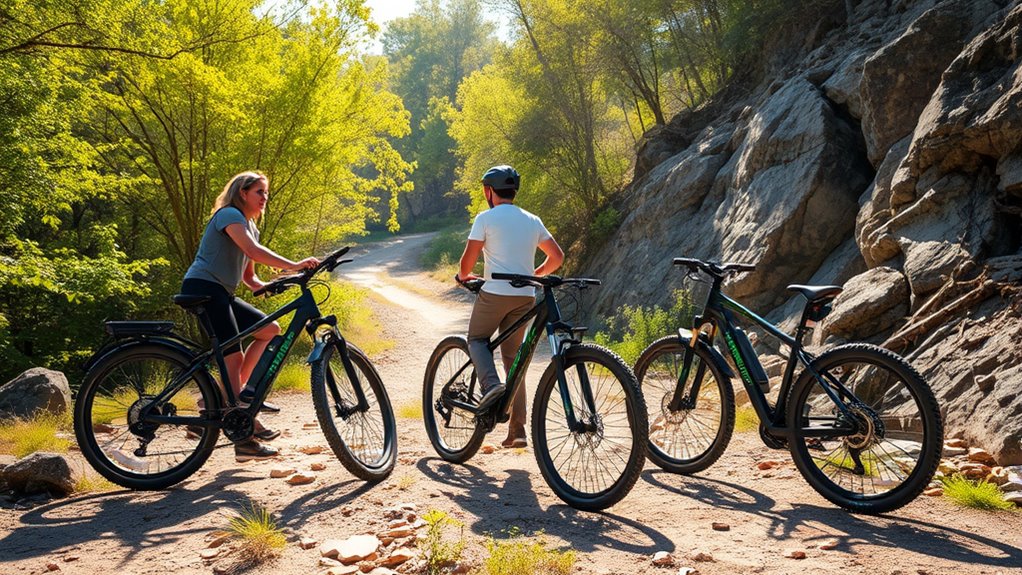
Choosing the right motor wattage depends heavily on the terrain you’ll be riding. If you plan to tackle steep hills or rugged trails, opt for a higher wattage motor, which provides more power and better performance. For flatter surfaces or casual rides, a lower wattage motor can be sufficient, helping to conserve battery capacity and increase riding time. Keep in mind that motor efficiency plays an essential role; a more efficient motor delivers better performance without draining your battery as quickly. Advances in motor technology are continuously improving efficiency, allowing for better performance even at lower wattages. Matching wattage to your terrain ensures you get enough power when needed while optimizing battery life. This balance helps you enjoy longer rides and reduces the need for frequent recharging, making your e‑bike experience more enjoyable and practical.
Understanding Power and Battery Compatibility
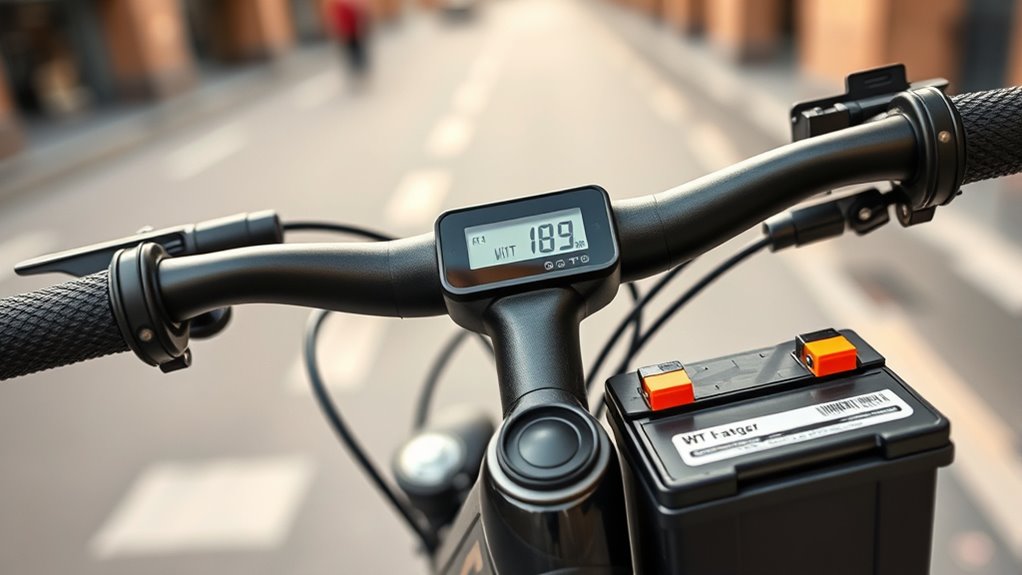
To guarantee your e-bike performs reliably, it’s vital to match the motor’s power with the battery’s capacity. Battery technology varies, affecting how much energy your battery can store and deliver. A compatible battery ensures your motor runs efficiently without overloading or underperforming. Pay attention to the battery’s voltage and capacity, as these directly impact power output and compatibility. Motor efficiency also matters; a high-efficiency motor uses energy more effectively, maximizing performance with less strain on the battery. Mismatched components can lead to reduced range, overheating, or early wear. Proper tuning techniques can optimize your system’s overall performance and longevity. Always check manufacturer recommendations to ensure your battery and motor are designed to work together, providing ideal power while maintaining longevity and safety.
How Wattage Influences Range and Battery Life
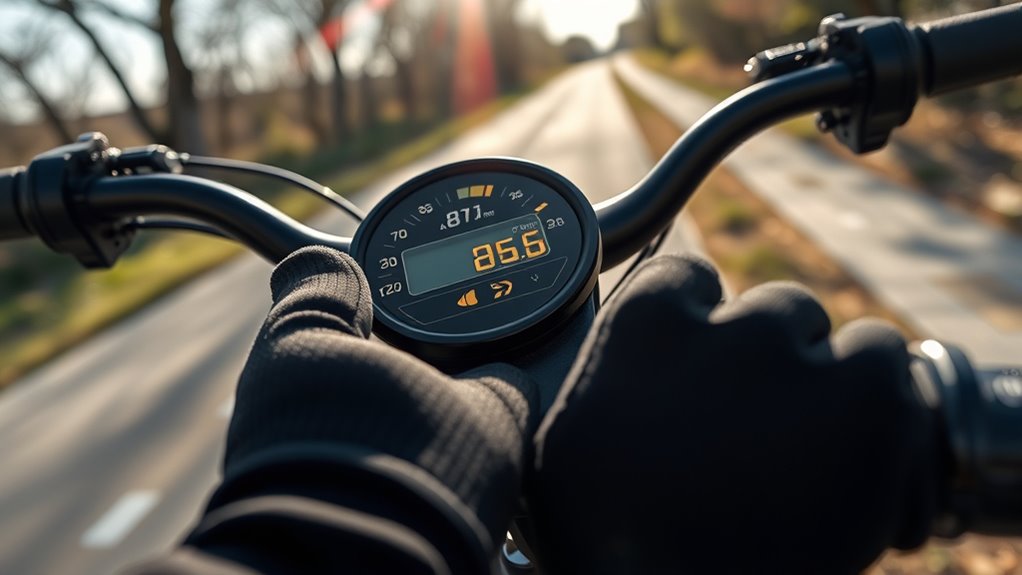
Wattage plays a key role in determining how far your e-bike can go on a single charge and how long the battery lasts during rides. Higher wattage motors often draw more power, which can drain the battery faster if the motor isn’t efficient. However, motor efficiency also matters; a more efficient motor uses less energy to generate the same power, extending your range. Battery capacity, measured in watt-hours (Wh), directly influences how long you can ride before needing a recharge. Combining the right wattage with a high-capacity battery ensures you get the most out of your ride without sacrificing battery life. Additionally, Kia Tuning techniques can optimize vehicle performance, which is analogous to fine-tuning your e-bike for better efficiency and range. Keep in mind that higher wattage doesn’t always mean better range—efficiency and battery capacity are vital factors.
Choosing the Right Wattage for Commuting and Leisure
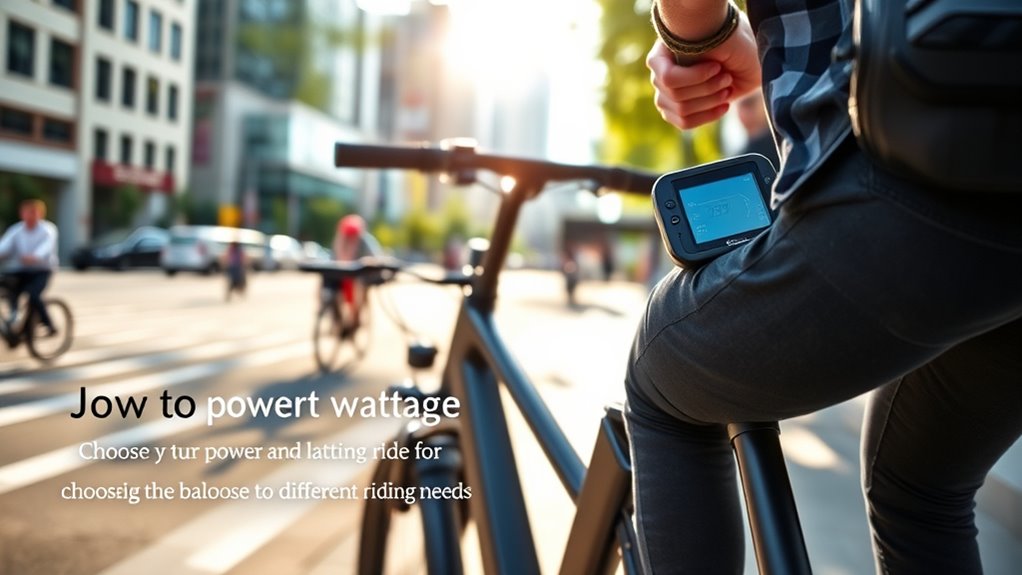
To choose the right wattage, you need to assess your power needs based on your typical routes and riding style. Consider how terrain and distance might affect the motor’s performance, and be aware of local laws that limit wattage. Making these factors clear will help you pick an e-bike that fits your commuting or leisure goals perfectly. Additionally, understanding industry trends can help you select a model with features that remain relevant and valuable over time.
Power Needs Assessment
How do you determine the ideal wattage for your e‑bike to match your commuting or leisure needs? Start by evaluating your typical riding patterns and terrain. Consider that advances in battery technology enable longer rides with less weight, while motor efficiency impacts power delivery. To find the right wattage, think about:
- Your daily distance and speed requirements.
- The level of assistance needed for hills or headwinds.
- The balance between motor power and battery life.
- The use of features like eye patches that can influence your comfort levels during rides.
Higher wattage motors offer more power but drain batteries faster, especially if motor efficiency isn’t optimized. Matching wattage with your riding style ensures you get enough power without unnecessary weight or reduced battery life. Proper power needs evaluation helps you select an e‑bike that performs reliably for your specific needs.
Terrain and Distance Factors
When choosing the right wattage for your e-bike, understanding the terrain and typical riding distances is essential. Hilly or rugged terrain demands a higher wattage motor to handle inclines without draining your battery too quickly. Conversely, flat terrains may require less power, conserving battery capacity for longer rides. Distance also plays a key role; if you commute several miles daily, selecting a motor with high efficiency ensures you get the most from each charge. Keep in mind that motor efficiency directly impacts how well your battery capacity is utilized—more efficient motors deliver longer range and better performance. Additionally, consider drivetrain components that can influence how effectively power is transferred, impacting overall efficiency and performance. Balancing wattage with terrain and distance needs helps you choose an e-bike that performs reliably without sacrificing battery life or power.
Legal Restrictions and Limits
Legal restrictions and limits considerably influence the wattage you should choose for your e-bike, especially for commuting and leisure riding. Many regions cap motor power to guarantee safety and compliance, often around 750W or less. When selecting wattage, consider your battery capacity—higher wattage can drain the battery faster—and motor efficiency, which affects how well power translates into performance. Additionally, choosing a wattage that aligns with Vetted standards helps ensure your e-bike remains within legal parameters. Here are key points to keep in mind:
- Check local laws to avoid penalties or needing additional licensing.
- Opt for a wattage that balances power and battery life for your typical rides.
- Consider motor efficiency to maximize performance within legal limits.
Staying within legal limits ensures smooth rides without legal complications.
Legal Restrictions and Wattage Limits in Different Regions
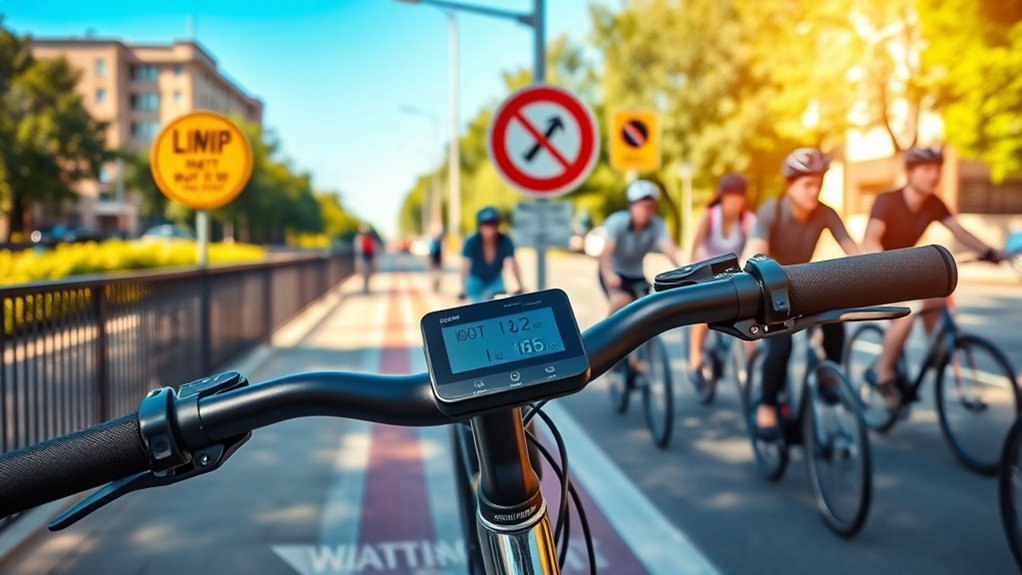
Because regulations vary widely across regions, it’s essential to understand the specific wattage limits that apply where you plan to ride your e-bike. Different areas set maximum wattage to control speed and ensure safety, often influenced by battery capacity and motor efficiency. For example, some regions limit e-bikes to 250 watts, while others allow up to 750 watts. These limits are designed to keep e-bikes within legal classifications, affecting where and how you can ride. It’s important to check local laws before purchasing or riding, as exceeding wattage caps can lead to fines or restrictions. Understanding these regional restrictions helps you choose an e-bike that complies with legal standards, ensuring a smooth, trouble-free riding experience. Additionally, wattage limits are often related to the classification of e-bikes, which can impact insurance and licensing requirements.
Tips for Selecting the Perfect Wattage for Your Needs
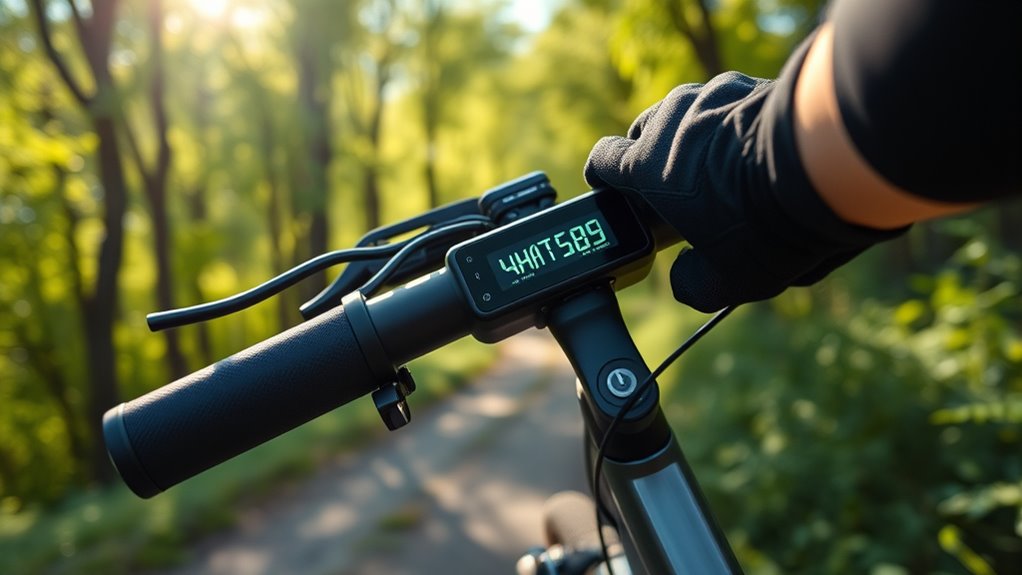
Choosing the right wattage for your e-bike depends on how you plan to use it and your riding environment. Higher wattage motors offer more power but can drain the battery faster, so consider your battery capacity. To select the perfect wattage, keep these tips in mind:
- Evaluate your terrain—hilly areas may require higher wattage for better motor efficiency.
- Think about your typical ride distance—longer trips benefit from a lower wattage with higher battery capacity.
- Match wattage to your riding style—aggressive riders might prefer more power, while casual riders can opt for lower wattage to conserve energy.
- Considering Volkswagen Tuning principles, optimizing motor performance can lead to better efficiency and satisfaction.
Balancing wattage with battery capacity ensures ideal motor efficiency, giving you the power you need without sacrificing range.
Frequently Asked Questions
How Does Motor Wattage Impact E-Bike Weight and Portability?
Higher motor wattage can increase your e-bike’s weight because it often comes with a larger battery size and stronger frame to support the motor. This makes the bike less portable and harder to carry, especially if you frequently lift or store it. You should consider your needs for power versus portability, balancing a more powerful motor with a manageable weight to suit your riding style and storage options.
Can Higher Wattage E-Bikes Be More Energy-Efficient?
Higher wattage e-bikes can be more energy-efficient if they have a larger battery capacity, which extends your riding range without needing to pedal harder. Although they use more power during intense acceleration, their bigger batteries help you go farther on a single charge. So, if you choose an e-bike with a higher wattage and ample battery capacity, you might find it more efficient for longer rides, saving you time and energy.
What Maintenance Considerations Are Affected by Wattage Levels?
Think of your e-bike as a finely tuned engine. Higher wattage puts more stress on components, affecting your battery lifespan and brake system maintenance. You’ll need to monitor the battery more closely, as it wears faster with increased power demands. Plus, the brake system endures extra wear from higher speeds. Regular checks and timely replacements help keep your e-bike running smoothly and extend its lifespan.
Are There Safety Concerns With Using Higher Wattage E-Bikes?
Using higher wattage e-bikes can raise safety concerns, especially regarding battery safety and rider experience. You may find the bike more powerful, but it also demands better control and awareness. Higher wattage bikes can generate more heat and stress on batteries, increasing the risk of overheating or failure. Always verify your e-bike’s specifications match your skill level and riding conditions to stay safe and enjoy a smooth rider experience.
How Does Wattage Influence the Initial Purchase Cost?
If you think wattage doesn’t matter, think again — it’s the secret sauce to your e-bike’s price difference! Higher wattage models often come with a heftier price tag, making budget planning a must. You might save initially with a lower wattage, but if you crave speed and power, be prepared to shell out more. So, your wattage choice directly impacts your wallet, making it a key factor in your purchase decision.
Conclusion
Think of choosing e-bike wattage like selecting a vehicle for a journey. Too low, and you’ll struggle uphill; too high, you might waste energy and break rules. Find the right wattage, and your ride becomes a smooth, confident voyage tailored to your terrain and goals. By matching your wattage to your needs, you guarantee a comfortable, efficient adventure—just like steering a well-tuned ship through calm waters. Your perfect e-bike journey awaits.
